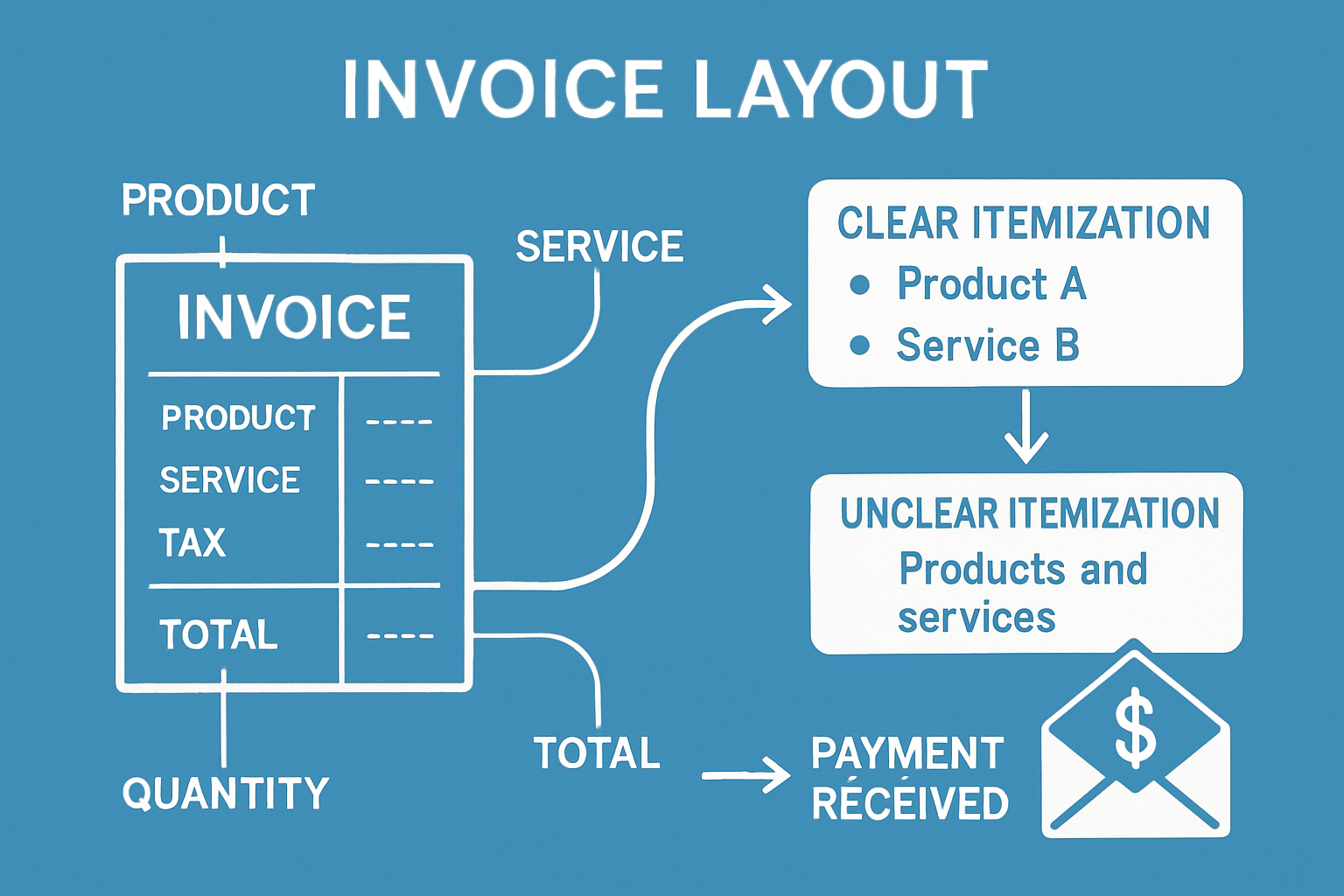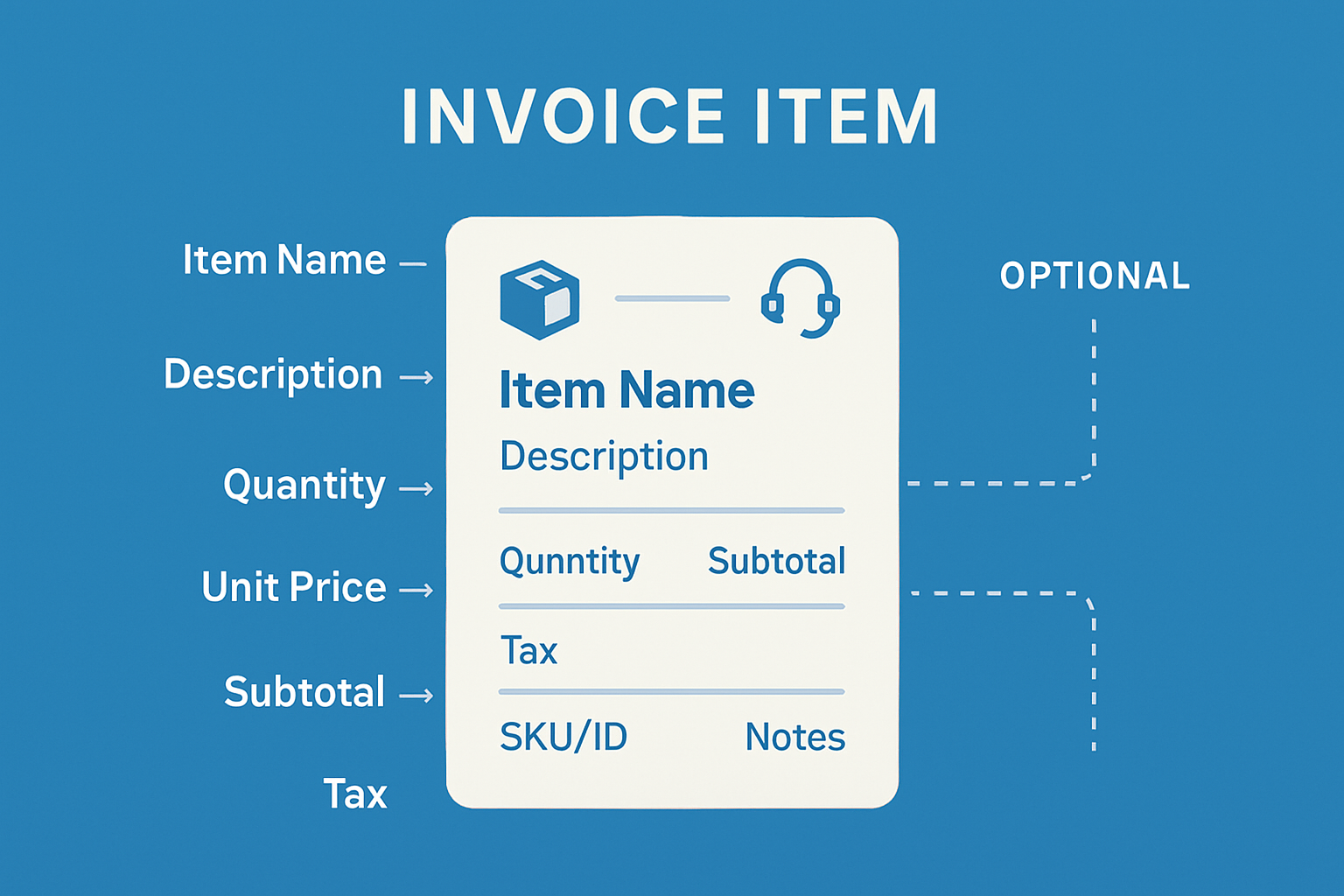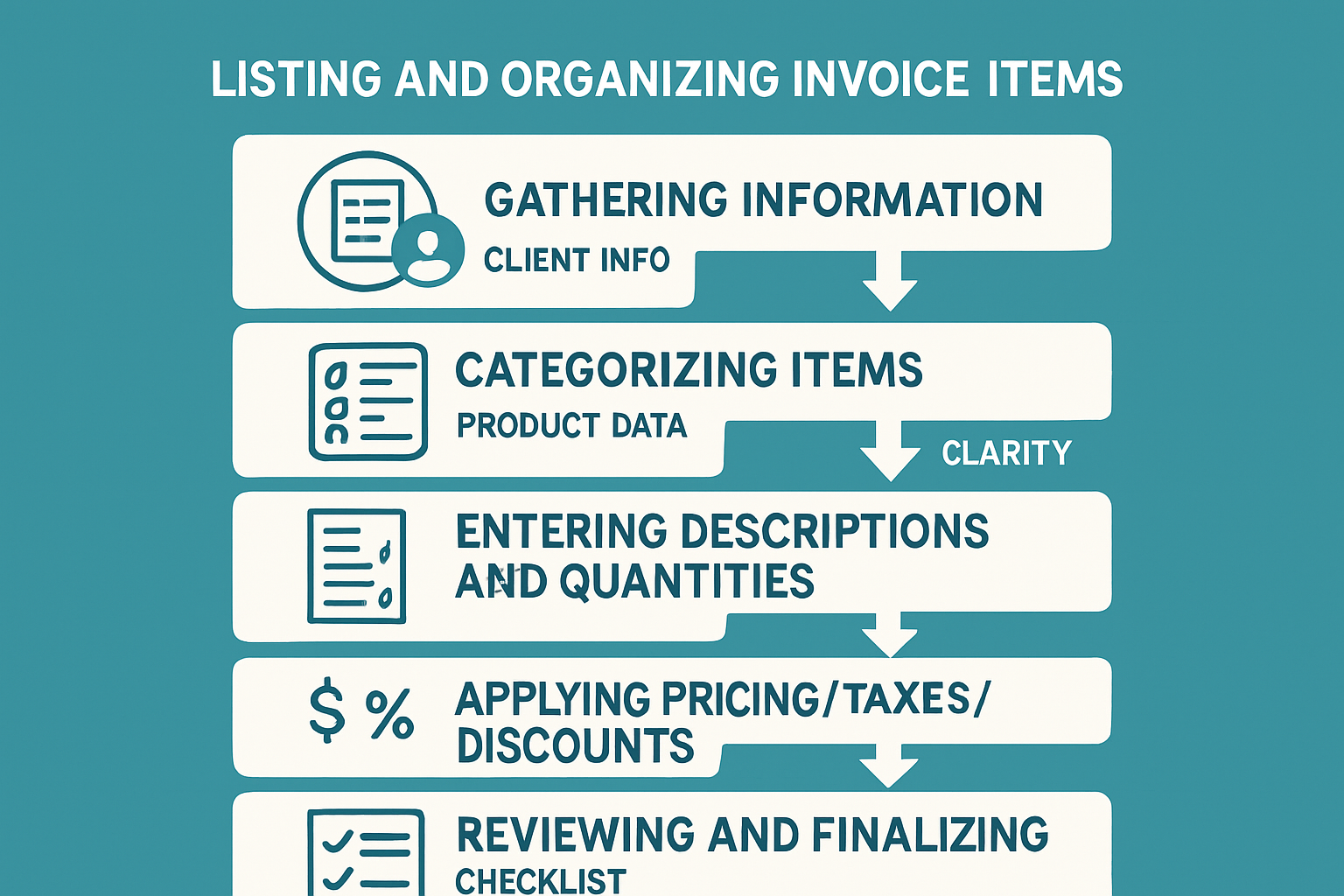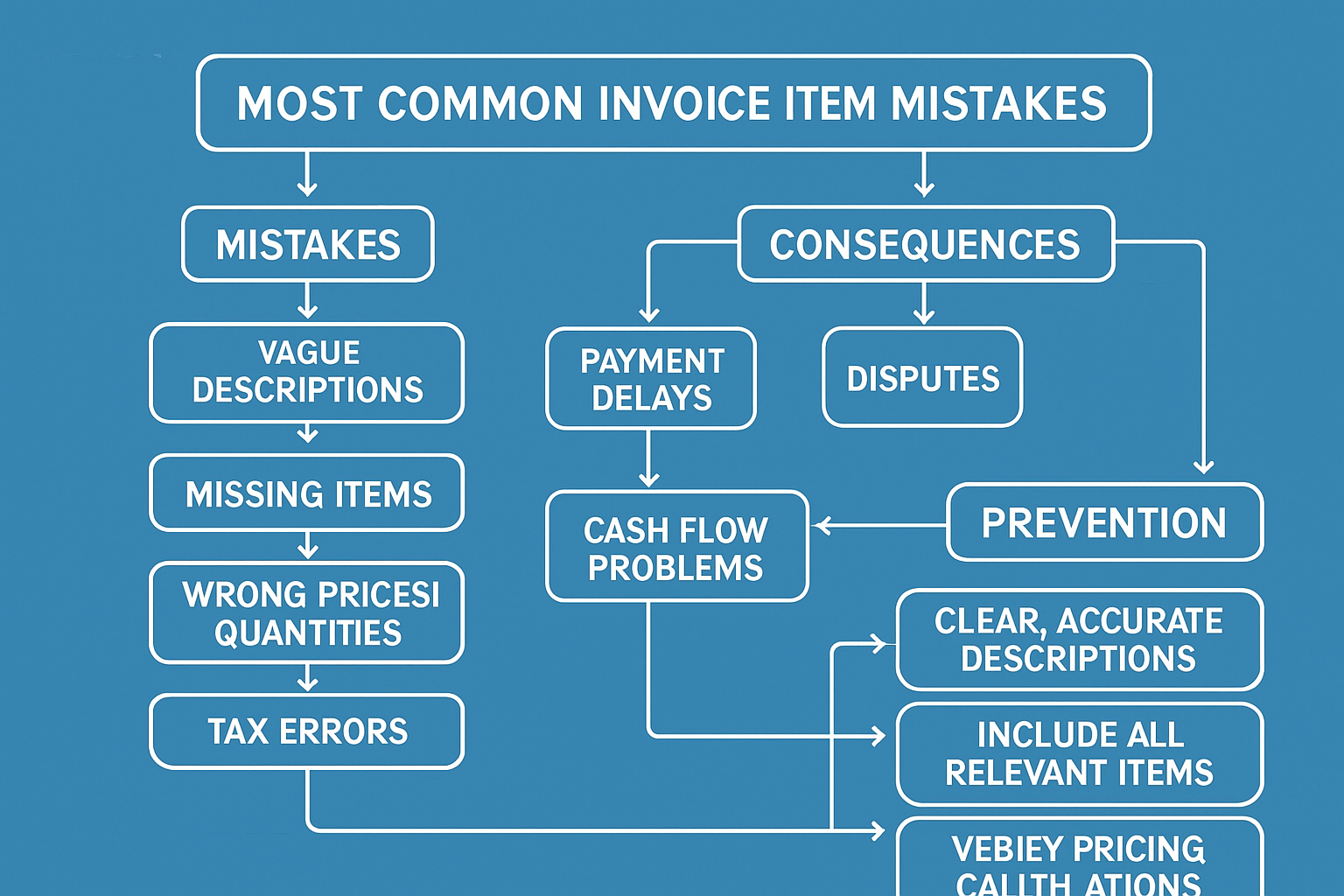Are you overwhelmed by confusing invoice items when sending or receiving bills for your business or freelance gigs? You're not alone—many beginners struggle to understand what invoice items mean or how to use them correctly. This guide will walk you through everything you need to know, from what invoice items are to how to list them properly, avoid costly mistakes, and leverage digital tools for accuracy. Mastering invoice items can lead to faster payments, fewer disputes, and smoother business operations. Ready to simplify invoicing? Let’s dive in and demystify the process together.

The Ultimate Guide to Invoice Items for Beginners 2025
Understanding Invoice Items: Definition and Importance
Feeling lost in a sea of numbers and line items on your invoices? You’re not alone. Many beginners struggle to grasp the true role and importance of invoice items. Let’s break it all down, step by step.

What Are Invoice Items?
Invoice items are the individual lines on an invoice that detail exactly what a buyer is being charged for. Each line represents a unique product, service, or fee. Listing these items clearly provides both the seller and the buyer with a transparent record of the transaction.
Without precise invoice items, both parties may struggle to understand what’s being billed, potentially leading to confusion and unnecessary back-and-forth.
Types of Invoice Items: Products, Services, and More
Not all invoice items are created equal. They typically fall into three main categories:
- Products: Tangible goods like laptops, books, or office supplies.
- Services: Intangible offerings such as consulting hours, design work, or repairs.
- Miscellaneous Charges: Shipping, handling, or special fees.
Understanding which type of invoice items you’re listing is key. For example, a freelance designer’s invoice items may focus on hours worked, while a retailer’s will highlight product quantities and models.
Why Accurate Invoice Items Matter
Accurate invoice items are essential for clear communication and smooth business operations. When invoice items are detailed and correct, clients can easily verify what they’re being charged for. This transparency helps avoid payment delays and reduces the chance of disputes.
According to a 2023 QuickBooks survey, 37% of late payments happen because of unclear or missing invoice details. Using Invoice automation software benefits can further streamline item accuracy, making sure every charge is crystal clear.
Legal, Tax, and Financial Implications
Detailed invoice items aren’t just about clarity—they’re also a legal and tax requirement in many regions. Properly itemized invoices support tax reporting, VAT calculations, and compliance with local regulations. Missing or vague invoice items can trigger audits or fines.
From an accounting perspective, accurate invoice items enable better tracking of sales, expenses, and profitability. They also help businesses prepare financial reports and forecast future trends.
Real-World Impact: Examples and Data
Consider these two invoice examples:
| Invoice Type | Description Quality | Likely Outcome |
|---|---|---|
| Well-Structured | “20x Blue T-Shirts, Size M, Model 2025” | Quick approval and payment |
| Poorly Itemized | “Shirts” | Client confusion, payment delay |
Clear invoice items can speed up payment cycles, strengthen client relationships, and provide a reliable record for audits. With 37% of late payments linked to unclear invoices, it’s easy to see why mastering invoice items is a must for any business or freelancer.
Key Components of an Invoice Item
Breaking down invoice items into their essential components is the first step toward creating clear, professional invoices that get you paid promptly. Each detail you include not only supports accuracy but also protects your business from disputes and compliance issues.

Core Components Table
| Component | Description | Example |
|---|---|---|
| Item Name | What is being billed | "Consulting Hour" |
| Description | Detailed info for clarity | "Website design, 10 hours" |
| Quantity | Number of units/hours | 10 |
| Unit Price | Price per unit/hour | $50 |
| Total | Quantity × Unit Price | $500 |
| Tax | Applicable tax rate/type | 8% sales tax |
| SKU/ID | Internal code or identifier | "WD-2025-01" |
| Notes | Extra info, terms, or clarifications | "Due in 30 days" |
Each of these elements plays a vital role in making invoice items easy to understand for both you and your clients.
Mandatory vs. Optional Fields
Depending on your industry, not every detail is required on all invoice items. Here’s a quick breakdown:
- Mandatory fields: Item name, description, quantity, unit price, total, and tax (if applicable).
- Optional fields: SKU/ID, notes, internal codes, custom terms.
For example, a freelance graphic designer may omit SKU/ID, while a retailer always includes it for inventory tracking.
Detailed Descriptions: Products vs. Services
Clear descriptions are the backbone of effective invoice items. For products, include brand, model, and specs. For services, specify scope, hours, or milestones.
Product example:
- "Lenovo ThinkPad X1 Carbon, Gen 11, 16GB RAM, 512GB SSD"
Service example:
- "Logo redesign: 8 hours, includes 2 initial concepts and 3 revisions"
Vague descriptions like "Work done" or "Laptop" can slow down payments or trigger questions.
Standardization and Codes
Using standardized naming conventions and codes (SKUs or IDs) makes tracking and reporting on invoice items much easier. Many businesses rely on Top invoicing software 2025 to help automate and enforce consistency, reducing errors and misunderstandings.
Standardization also supports integration with accounting systems, ensuring data flows smoothly from invoices to reports.
Units, Tax Codes, Discounts, and Surcharges
Always specify units (e.g., hours, pieces, licenses) to avoid confusion. Tax codes must be accurate and match what’s required by law in your region.
When offering discounts or adding surcharges, list them as separate invoice items for transparency.
Example:
- Discount: "Early payment discount, 5% off subtotal"
- Surcharge: "Rush project fee, flat $75"
Sample Invoice Item Line
Here’s a real-world example using a code block for clarity:
Item Name: Web Hosting Renewal
Description: Annual subscription, 1 domain, SSL included
Quantity: 1
Unit Price: $120
Total: $120
Tax: $9.60 (8%)
SKU/ID: WH-2025-02
Notes: Auto-renews next year
Getting these core elements right in your invoice items ensures transparency, faster payments, and easier compliance down the road.
Step-by-Step Guide: How to List and Organize Invoice Items
Getting invoice items right is essential for smooth business operations and prompt payments. Whether you’re a freelancer or managing a growing business, following a structured approach ensures your invoices are clear, accurate, and professional.

Step 1: Gather Necessary Information
Before you start listing invoice items, collect all the details needed for a complete invoice. This includes product or service descriptions, pricing, client information, and the date of the transaction.
Double-checking item accuracy early helps prevent costly mistakes later. Use a checklist or a digital template to ensure nothing is missed. Many teams collaborate with sales or project managers to verify all deliverables are included as invoice items.
A best practice is to standardize your data-gathering process. Explore Accounts payable automation trends 2025 to see how automation is streamlining the collection and verification of invoice items in modern finance teams.
Step 2: Categorize and Sequence Items
Organizing invoice items logically makes invoices easier to read and approve. Group items by project phase, product category, or service type—whatever makes the most sense for your workflow and client.
For example, a web development firm might list design, development, and testing as separate sections, each with their own invoice items. Retailers might group products by category, such as electronics, accessories, and warranties.
Sequencing matters because it guides your client through the invoice step by step. Use section headers and sub-totals to break down complex invoices and simplify tax calculations. This approach also helps with reporting and compliance, as similar invoice items can be easily tracked.
Step 3: Enter Detailed Descriptions and Quantities
Clarity is key when describing invoice items. Avoid vague labels like “consulting” or “parts.” Instead, specify details such as brand, model, hours worked, or service dates.
For products:Dell Latitude 7420 Laptop, Intel i7, 16GB RAM, 512GB SSD – 2 units
For services:Content writing for June blog posts, 10 hours at $50/hour
Matching invoice items to contracts or purchase orders ensures consistency and reduces payment delays. The more specific your descriptions, the fewer questions your client will ask, speeding up approvals.
Step 4: Apply Pricing, Taxes, and Discounts
Once your invoice items are listed and described, enter the correct unit prices, tax rates, and any discounts or surcharges. For each item, calculate the total by multiplying quantity by unit price, then add applicable taxes.
Example:Web Design – 20 hours @ $75/hour = $1,500 + 10% VAT = $1,650
List discounts and surcharges as separate invoice items for transparency. Double-check that your totals match contract agreements and reflect all negotiated terms.
Step 5: Review, Edit, and Finalize
Proofreading is crucial before sending invoices. Review all invoice items for accuracy—look for duplicate entries, missing items, or incorrect taxes. Use a checklist to ensure every field is complete.
Modern invoicing software often includes validation features to catch errors automatically. Common mistakes include typos in descriptions, misapplied tax codes, or incorrect totals. Taking the time to review invoice items protects your business and builds client trust.
Before you hit send, ask a colleague to review the invoice or leverage software audits for added confidence. A thorough final check ensures your invoice items are accurate, helping you get paid faster and avoid disputes.
Common Mistakes and How to Avoid Them
Navigating invoice items can be tricky, especially for beginners. Even small errors in invoice items can cause big headaches, from delayed payments to lost client trust. Understanding where things commonly go wrong—and how to prevent these pitfalls—will help you build a smoother, more professional invoicing process.

Frequent Mistakes with Invoice Items
Mistakes with invoice items are surprisingly common. Here are the most frequent errors:
- Vague or generic descriptions: Using unclear terms like "services rendered" can confuse clients.
- Missing items: Forgetting to list all products or services provided.
- Incorrect quantities or prices: Mistyped numbers or outdated rates.
- Tax miscalculations: Applying the wrong tax rate or missing taxes entirely.
These issues often happen when details are rushed, or a standard template isn’t used. For example, a freelancer might list “Consulting” without hours worked, making it hard for the client to verify.
The Real Impact of Invoice Item Errors
Errors in invoice items don’t just look unprofessional—they can seriously disrupt your business. Payment delays are a direct result, as clients may question unclear or incorrect charges. In some cases, disputes arise, leading to lost business or strained relationships.
According to Xero, 28% of small businesses experience cash flow issues due to invoicing errors. Even a single mistake in your invoice items can set off a chain reaction, impacting your bottom line and reputation.
Preventing Mistakes: Templates, Training, and Reviews
You can minimize errors in invoice items by adopting a few best practices:
- Use standardized templates. Pre-built templates help ensure all necessary details are included.
- Double-check details. Always review quantities, prices, and descriptions before sending.
- Regular staff training. Keep your team updated on invoicing standards and tax rules.
- Implement review processes. Have a second person review invoices, especially for large or complex jobs.
Consider this real-world example: A design agency once billed a client with missing line items and vague descriptions. The client delayed payment for weeks, asking for clarifications. After switching to detailed invoice items and regular team reviews, their payment cycle improved dramatically.
Harnessing Automation and Tools for Accuracy
Modern tools can dramatically reduce errors in invoice items. Automation ensures consistent, accurate entry—no more copying and pasting mistakes. Many businesses now turn to specialized invoicing software or Robotic Process Automation (RPA) tools.
If you’re considering automation, check out the Best RPA software 2025 for top solutions that can help streamline repetitive invoicing tasks. These tools not only save time but also flag inconsistencies before invoices reach your clients.
Quick Troubleshooting Checklist
Before sending out invoices, use this checklist to catch common mistakes:
- Are all invoice items clearly described?
- Did you include every product or service provided?
- Are quantities and prices accurate?
- Have taxes been calculated correctly?
- Did you review the invoice for typos or duplicates?
A careful review ensures your invoice items are accurate, helping you get paid faster and build client trust.
Digital Tools and Automation for Invoice Items in 2025
Are you tired of manually tracking invoice items and worrying about costly mistakes? In 2025, digital tools have transformed how businesses create, manage, and automate invoice items. With new technologies, even beginners can streamline their invoicing processes and stay ahead of the curve.
Popular Invoicing Tools for Invoice Items in 2025
Digital invoicing platforms are now essential for managing invoice items efficiently. Tools like QuickBooks, FreshBooks, and Zoho Invoice offer user-friendly interfaces, customizable templates, and robust item tracking features. These solutions make it easy to add, edit, and organize invoice items for any business model.
Many tools support bulk import of invoice items, automated reminders for overdue payments, and integration with payment gateways. This means you can handle everything from item entry to payment collection in one place.
For a deeper dive into automation, you might explore QuickBooks, a market leader known for its seamless invoice item management and advanced reporting features.
The Benefits of Automation for Invoice Items
Automation is a game changer for handling invoice items. By letting software handle repetitive tasks, you reduce manual entry, eliminate common errors, and speed up the entire invoicing process. This is especially valuable for businesses dealing with high volumes of invoice items each month.
Let’s look at the main benefits:
- Faster Processing: Automated tools generate invoices with multiple invoice items in seconds.
- Greater Accuracy: Calculations, taxes, and totals are handled automatically, minimizing mistakes.
- Improved Cash Flow: Automated reminders and streamlined itemization help reduce late payments.
According to Statista, 55% of businesses plan to automate invoicing by 2025, highlighting the growing demand for efficient invoice item management.
Trends Shaping Invoice Item Automation in 2025
In 2025, AI-powered features are revolutionizing invoice items management. Smart templates suggest item categories and descriptions based on your history, while machine learning algorithms extract invoice items from uploaded PDFs and images.
Some platforms now offer real-time analytics dashboards. These help you spot trends in invoice items, monitor payment statuses, and optimize your pricing strategies. Integration with accounting and ERP systems is also becoming standard, ensuring your invoice items flow seamlessly into your broader financial records.
Staying ahead of these trends means your business can process invoice items faster, more accurately, and with less hassle than ever before.
Choosing the Right Digital Tool for Your Business
Selecting the perfect tool for managing invoice items depends on your business size, industry, and workflow needs. Small businesses may prefer simple platforms with drag-and-drop functionality, while larger companies might need advanced automation and integration features.
Here’s a quick comparison:
| Tool | Best For | Key Features |
|---|---|---|
| QuickBooks | All business sizes | Automated invoice items, reporting, payroll |
| FreshBooks | Freelancers/SMBs | Simple interface, expense tracking |
| Zoho Invoice | Growing businesses | Custom templates, multi-currency support |
When evaluating options, consider scalability, customer support, and how well the tool handles your specific invoice items workflow.
Security and Privacy in Digital Invoicing
With sensitive data like invoice items, security is critical. Most modern invoicing tools use encryption, secure cloud storage, and regular software updates to protect your information. Look for platforms that comply with major data protection regulations, such as GDPR or CCPA.
It’s also wise to set up role-based access, so only authorized team members can view or edit invoice items. Regular audits and strong password policies further enhance your security posture.
By prioritizing privacy and security, you ensure your invoice items remain protected—giving you and your clients peace of mind.
Best Practices for Accurate and Compliant Invoice Items
Navigating the world of invoice items can be tricky, especially when accuracy and compliance are on the line. Getting these details right isn't just about avoiding mistakes—it's about building trust and keeping your business running smoothly.
Understanding Legal Requirements
Every region has its own rules for invoice items. In the US, invoices must detail what was sold, include unique identifiers like invoice numbers, and clearly state tax rates and totals. The UK and EU require even more, such as VAT registration numbers and itemized breakdowns for each line.
Missing mandatory details on invoice items can lead to rejected invoices or compliance penalties. Always check your local tax authority's requirements before sending invoices, and keep templates updated to reflect any regulatory changes.
Embracing Digital Compliance
Digital signatures and electronic records are becoming the norm for compliant invoice items. They provide proof of authenticity and help meet e-invoicing regulations in many countries.
Modern invoicing tools let you add secure digital signatures, store electronic copies, and track document versions. This reduces the risk of disputes and ensures your invoice items are always accessible and verifiable.
Consistency Across All Invoice Items
Consistency is key for professional invoices. Use the same branding, formatting, and terminology on every invoice. Standardized item names and descriptions help clients understand charges and make audits easier.
Here’s a quick comparison of compliant and non-compliant invoice items:
| Feature | Compliant Invoice Items | Non-Compliant Invoice Items |
|---|---|---|
| Description | "Web design services, 15 hours" | "Services" |
| Tax Details | VAT 20% clearly shown | Tax missing or unclear |
| Currency | USD, GBP, or EUR specified | No currency listed |
| Digital Signature | Present (if required) | Absent |
Audits, Reconciliations, and Risk Reduction
Regular audits and reconciliations help catch errors in invoice items before they become bigger problems. Schedule periodic reviews of your invoicing process to ensure every detail aligns with contracts and local laws.
Clear invoice items make audits faster and reduce the risk of financial penalties. If you use accounting software, take advantage of built-in audit trails and error checks for added peace of mind.
International Considerations
If you invoice across borders, pay close attention to international rules. List currencies clearly, convert amounts at the agreed rate, and adjust invoice items for country-specific taxes or requirements.
Using multi-currency invoicing tools simplifies this process. They ensure your invoice items remain accurate and compliant, no matter where your clients are based.
Ongoing Education and Staying Current
Regulations for invoice items can change quickly. Subscribe to updates from your local tax authority or trusted invoicing platforms to stay informed. For example, HMRC’s invoicing guidance is a reliable resource for UK businesses.
Invest in training for your team on the latest compliance standards. The more you know, the less likely errors will creep into your invoice items.
In summary, mastering best practices for invoice items takes effort, but it pays off in fewer disputes, faster payments, and stronger client relationships. Make accuracy and compliance a habit, and your invoicing process will always be one step ahead.
Now that you’ve got a handle on the essentials of invoice items and how to organize them for clarity and compliance, why not make the whole process even easier? If you’re tired of manually entering invoice data or worrying about missing details, there’s a smarter way. With AI-powered tools, you can extract line items, vendor info, and amounts in seconds—no templates, no fuss. I’d recommend trying the Free Invoice Parser to save time and boost your accuracy. It’s a simple step toward streamlining your invoicing workflow as you put these best practices into action!
